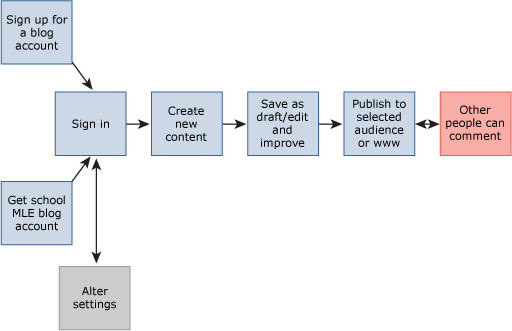Exploring classroom blogs

In this part of the course you will go on an online field trip and evaluate classroom blogs using a checklist. Reflect on what you have learnt from this activity when engaged in this task.
Blogs are already being used extensively for many different educational purposes and more generally as a source of information and sharing on the web.
The next activity gives you a chance to explore some examples of how teachers are using blogs and at the same time think about how they are structured.
Blogs can be made to look very different. For example they can be embedded in a website like the BBC or they can be stand alone like the blogs we have looked at so far. However, the principle behind them is the same. They provide an easy interface based on form filling that enables us to publish content without the need to learn how to write web pages.
The basic blogging process is shown by the diagram below and explained by this video [Tip: hold Ctrl and click a link to open it in a new tab. (Hide tip)] from Russell Stannard. Browse relevant sections on the menu bar.

A key point to remember about blogs is that they allow for learning and sharing to go on over time, not constrained by ‘the lesson or session’, and to go on over space not constrained by the physical buildings.
Activity 5 Online field trip
![]() The objectives of this course activity are to:
The objectives of this course activity are to:
- explore existing blogs used for learning and teaching
- reflect on how these blogs are being used
- share thoughts about how they are being used.
5.1 Evaluating classroom blogs
Below are several examples of the use of blogs in the classroom. Select two blogs that are of interest and relevance to you. Think about how they are being used for learning and teaching using this Blog evaluation checklist. Post your evaluation in the course forum.
| Key stage | Subject area | Why visit the site and what to look for... |
| 3–4 | Modern Foreign Languages (MFL) | Weald of Kent Grammar School MFL Blog includes student created songs, interviews (podcasts) and use of a video tools such as YouTube and Voki. Students create avatar vokis as a way of learning new ICT skills and another language. To view these, and student reflections, scroll down the page and look for 'Project 1 Avatars - student reviews'. Note: This blog has some very good student examples but is not easy to navigate – why not? |
| 3–4 | Cross Curricular | Belfast Model School for Girls. This blog includes information for students and parents and an easy to use photo gallery that celebrates events throughout the year. The school uses Moodle so student work is password protected. |
| 4 | English | Year 10 Web 2.0. Collaboration for GCSE was set up by a teacher at Newent Community School. This blog aims to encourage students to write for an audience. Students write about their work experience placement and comment on their peers contributions. A case study of this project is available in the 'Further Reading' section. |
| 4 | English, Media | ETC English and Media Review Blog, developed by a teacher at Eastbourne Technology College, Sussex. The site enables students to review media including books, films, adverts and games. A case study of this project is available in the 'Further Reading' section... |
| 3–4 | Science – Biology | Extreme Biology, was set up by a secondary biology teacher in America. The blog seeks contributions about 'anything biology related'. She turned the blog over to her students in 2007 and has been thrilled with the results. |
![]() 5.2 The last criteria on the Blog evaluation checklist asked you to reflect on the overall learning experience of the students. Go to the forum and share your reflections on this and any other thoughts you have on the use of blogs. You should expect to go back to the forum at least three times to take part in the discussion and respond to others.
5.2 The last criteria on the Blog evaluation checklist asked you to reflect on the overall learning experience of the students. Go to the forum and share your reflections on this and any other thoughts you have on the use of blogs. You should expect to go back to the forum at least three times to take part in the discussion and respond to others.
Teacher Voice
I started blogging for my students in 2006. During the first year I only used the blog to post class information. In 2007 I decided to turn the blog (Extreme Biology) over to my students and have been thrilled at the results. It has greatly increased student involvement and science literacy in my classroom.
During your online field trip you will have noticed that bloggers often use additional tools andWeb 2.0 technologies within their blog posts. It is beyond the scope of this course to cover the full-range of options in detail, but it might be useful to be aware of some of the tools that you might wish to explore in the future. You may have noted some of these down when you completed the Blog evaluation checklist.
Activity 6 Using other Web 2.0 technologies with blogs
![]() The objective of this course activity is to develop your knowledge and understanding of the tools and technologies that are useful in combination with blogs.
The objective of this course activity is to develop your knowledge and understanding of the tools and technologies that are useful in combination with blogs.
Read the information below and follow the links to points of particular interest to you. You may wish to ask questions about these and share ideas in the course forum.
Commonly used tools and Web 2.0 technologies at a glance:
RSS is a widely used technology that allows us to share content over the internet and display it in different places, in different ways. This will be of value if you want to pull together different blog posts into one place. This means that you don't have to visit each blog separately to read the published material. Websites often use asymbol to indicate where an RSS 'feed' can be picked up from. For more explanation of this (and to see an example of the symbol) read the BBC website and search on the internet using a term like 'RSS education'.
Photo sharing is a popular activity that is easy and fun to do so many schools use this tool. When images are uploaded they can be embedded in other blog posts using the instructions given by the various photo sharing tools. This usually involves copying and pasting some code. One of the best known tools is Flickr which allows users to upload and share photos openly and make comments. You will find other options if you search the internet.
Video sharing is arguably dominated by YouTube and in many ways also requires a practice that is similar to blogging. Videos are uploaded and shared with the option of commenting. By following simple instructions it is also easy to embed video in blog posts and it brings another dimension to posts, making them more accessible to some students.
Online presentation tools replicate some of the features of software like PowerPoint that can be embedded in your blog posts. This can be done by copying and pasting some code supplied and following the instructions given. Google Presentations is a good example of this kind of tool. A web search on the term 'online presentation tools' will find many more that you might wish to explore.
Bookmarking tools such as delicious offer a simple way of sharing resources that are published on the web and embedded in your blog posts or website. Some web browsers also offer additional features that enable you to easily manage your collections of resources without the need to log into the bookmarking website itself.
Online maps can easily be embedded from a number of different tools. Apart from the obvious GoogleMaps (which is probably one of the most commonly used online mapping tools) there are other providers such as Bing Maps. A quick search on the internet will reveal more examples.
Copyright and blogs
